Unforgettable Captain Cook Snorkel Tour on Big Island
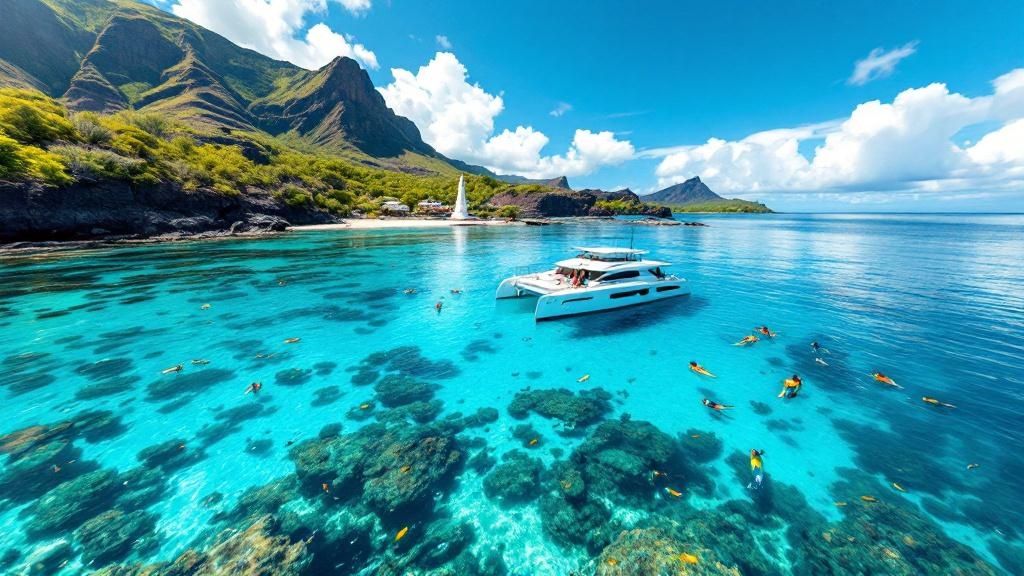
Picture yourself slipping into the warm, turquoise waters of Kealakekua Bay. Below you, a whole world of vibrant coral gardens and dazzling schools of tropical fish unfolds. You're not just swimming; you're floating above a piece of living history. This is the heart and soul of a Captain Cook snorkel tour—an experience that truly captures the magic of the Big Island.
Why This Snorkel Tour Is a Big Island Highlight
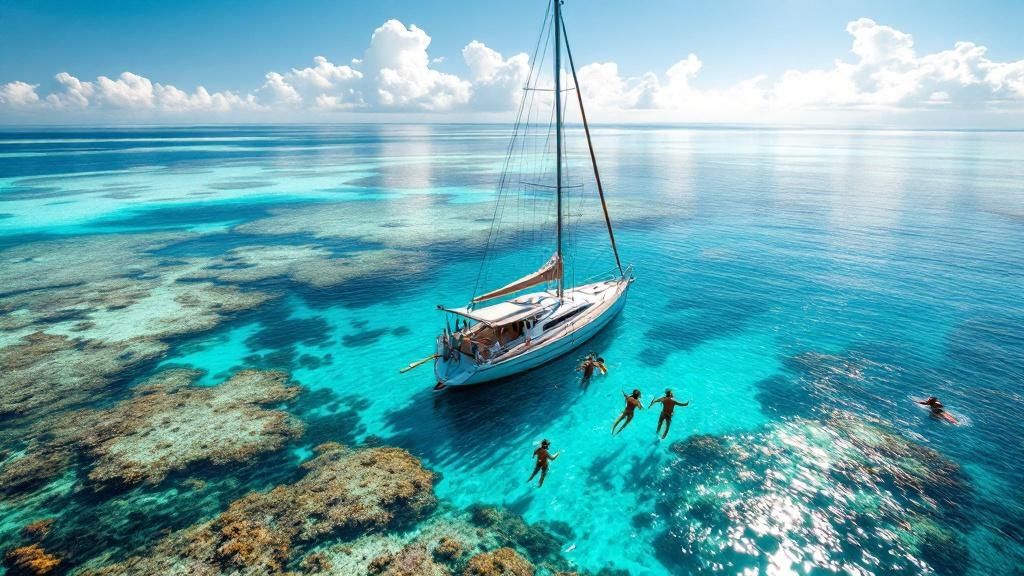
There’s a good reason the Captain Cook snorkel tour is always at the top of every "must-do" list for the Big Island. It’s so much more than just a boat trip out to a pretty spot. You're heading into Kealakekua Bay, which is a legally protected Marine Life Conservation District.
Think of it as the underwater equivalent of a pristine national park. Because of its protected status, the ecosystem here is incredibly healthy. The coral is bursting with color, and the fish are plentiful and don't spook easily. It creates an underwater spectacle that feels completely wild yet is surprisingly easy to access.
A Fusion of Nature and History
What really sets this trip apart is that you’re exploring a living museum. The bay is famous for being the place where British explorer Captain James Cook first made contact with Hawaiians in 1779 and, ultimately, where he died. This piece of history adds a powerful layer to the whole experience, turning a simple snorkel outing into something much deeper.
This one-two punch of incredible nature and historical weight is a massive draw. The numbers back it up: Kealakekua Bay sees over 190,000 visitors every year, cementing its reputation as a world-class snorkeling destination. And while the underwater visibility can often top 100 feet, what's fascinating is that around 70% of visitors are just as interested in the story of Captain Cook as they are in the fish. It’s a genuine two-for-one adventure.
To give you a quick snapshot of what makes this tour so special, here’s a breakdown of its key elements.
Captain Cook Snorkel Tour At-a-Glance
| Feature | Description |
|---|---|
| Location | Kealakekua Bay, a pristine Marine Life Conservation District on the Kona coast. |
| Marine Life | Abundant tropical fish, vibrant coral reefs, and frequent sightings of spinner dolphins. |
| Historical Site | Home to the iconic Captain Cook Monument, marking a significant site in Hawaiian and world history. |
| Water Clarity | Renowned for its crystal-clear water, often providing visibility of 100 feet or more. |
| Accessibility | Best accessed by a boat tour, which preserves the bay's delicate ecosystem from heavy foot traffic. |
| Best For | Snorkelers of all levels, history buffs, families, and anyone looking for a unique Big Island experience. |
Ultimately, this blend of attractions ensures the tour has something for everyone—from the serious marine biology nerd to the history enthusiast, and especially for families wanting to create a lasting memory on the water.
Kealakekua Bay offers a rare opportunity to witness a flourishing reef system and connect with a pivotal moment in Hawaiian history, all in one afternoon. It’s an experience that engages both the senses and the mind.
If you're curious and want to dive deeper into what this trip involves, be sure to check out our complete guide to the Captain Cook snorkel tour.
The History Behind Kealakekua Bay
As you glide over the calm, protected waters of Kealakekua Bay, it's easy to get lost in the stunning underwater scenery. But the story of this place is just as compelling. Every captain cook snorkel tour is a trip back in time, and you're floating right over a pivotal moment in Hawaiian history.
The bay’s name itself, "Kealakekua," translates to "the pathway of the god," hinting at its deep cultural and spiritual importance long before any outsiders arrived. This wasn't just another pretty spot on the coast; it was a sacred and fertile area, home to a large Hawaiian population and revered for its connection to the god Lono.
It was into this charged atmosphere that British explorer Captain James Cook sailed in January 1779.
A Historic Arrival
Cook's arrival was a matter of unbelievable timing. He showed up during the makahiki festival, a four-month celebration dedicated to Lono, the god of agriculture, fertility, and peace. During this sacred period, all war was forbidden, and religious ceremonies were the focus of daily life.
So when Cook’s enormous ships appeared with their tall masts and white sails—looking remarkably like the traditional depictions of Lono—many Hawaiians viewed him with awe. They believed he might just be a physical manifestation of the god himself. Naturally, this led to a peaceful and incredibly hospitable welcome.
From Reverence to Conflict
But that peaceful relationship wasn't built to last. After restocking his ships, Cook departed, only to run into a fierce storm that snapped the foremast of his ship, the Resolution. This damage forced him to turn back to Kealakekua Bay for repairs just a few weeks later.
He was met with a totally different reception. The makahiki festival had ended, and the Hawaiians' initial awe had dissolved into suspicion and tension. Resources were getting scarce, and the cultural misunderstandings that were once overlooked now began to cause real friction.
Things finally boiled over when a small boat from one of Cook's ships was stolen. To get it back, Cook tried to take the high chief, Kalaniʻōpuʻu, hostage—a tactic he'd apparently used successfully in other parts of the world. Here, it sparked a violent confrontation right on the shore.
On February 14, 1779, the escalating conflict ended with the death of Captain James Cook and four of his marines. This event marked a dramatic and tragic turning point in the relationship between Hawaiians and the Western world.
This complex, somber history is what gives the bay its soul. The iconic white obelisk you see from your tour boat, the Captain Cook Monument, is a stark reminder of these events. Today's tours do a great job of weaving this incredible story into your snorkeling adventure, connecting you to the bay’s profound past. You can dive deeper into the historical accounts from sources like Fair Wind Cruises to get the full picture.
Knowing the history transforms your tour from a simple swim into a much more meaningful journey.
A Typical Captain Cook Snorkel Tour Itinerary
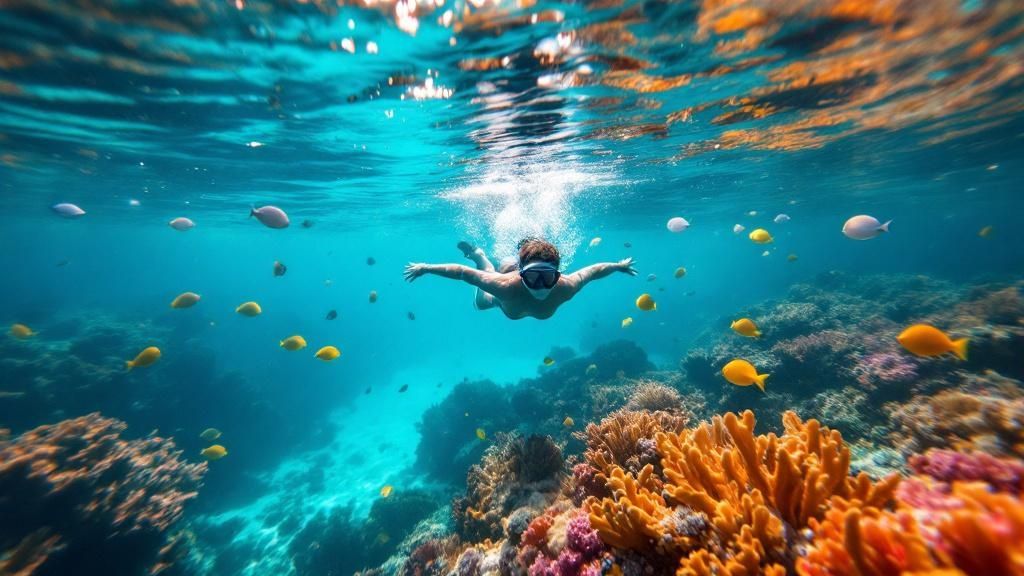
So, what’s a day on a Captain Cook snorkel tour really like? While every boat has its own unique style, most follow a pretty similar playbook. It's a rhythm that’s been perfected over the years to give you the best, safest, and most memorable experience possible. Think of it as a well-rehearsed show starring the gorgeous Kona coastline and its incredible marine life.
Your day usually kicks off with an early morning check-in at the harbor. This is where you'll meet the crew, get the paperwork out of the way, and get a quick rundown of what to expect. Right away, you’ll feel that friendly aloha spirit that really sets these trips apart. Once everyone's on board, the boat heads south, tracing the famous Kona coast.
The Scenic Cruise to the Bay
Let me be clear: this boat ride isn’t just about getting from point A to point B. It’s a huge part of the adventure. As you cruise, the captain and crew usually share stories, pointing out amazing geological features you’d never see from land. You'll glide past ancient lava flows frozen on the cliffsides and maybe even spot sea caves carved out by centuries of ocean power. And definitely keep your eyes peeled—it’s super common for pods of spinner dolphins to show up and play in the boat's wake.
The whole vibe changes as you enter the calm, sacred waters of Kealakekua Bay. The boat’s engine quiets to a low hum, and you'll immediately notice the water become clearer, calmer, and a stunning shade of turquoise. Then, you’ll see it: the iconic white Captain Cook Monument standing out against the lush green cliffs. It’s a powerful moment that connects you to the deep history of the place you’re about to explore.
The trip to the bay is more than just transit; it’s an integral part of the adventure. The coastal views and potential dolphin sightings build anticipation for the main event, making the arrival at the snorkeling site even more rewarding.
Plunging Into an Underwater World
Before anyone hits the water, the crew runs through a solid safety briefing. They'll show you how to get a good seal on your mask, go over hand signals for when you’re in the water, and explain the golden rule of the Marine Life Conservation District: look, but absolutely do not touch. They’ll also have flotation devices like noodles or vests for anyone who wants a little extra buoyancy.
Here’s a rough timeline for the snorkeling part of your day:
- Gear Up: The crew is hands-on, helping everyone get their snorkel gear fitted just right.
- Safety First: You'll get a clear, easy-to-understand briefing so everyone feels safe and ready.
- Snorkel Time: You can expect about 1.5 to 2 hours of prime time in the water to explore the reef at your leisure.
- Onboard Comfort: Most tours lay out snacks, drinks, and a great lunch right on the boat. It’s perfect for refueling and relaxing between your snorkeling sessions.
After you've had your fill of the underwater wonders, the crew helps everyone back on board. The cruise back to the harbor is just as scenic and gives you time to soak in the incredible memories you just made.
Discovering Kealakekua Bay's Marine Life
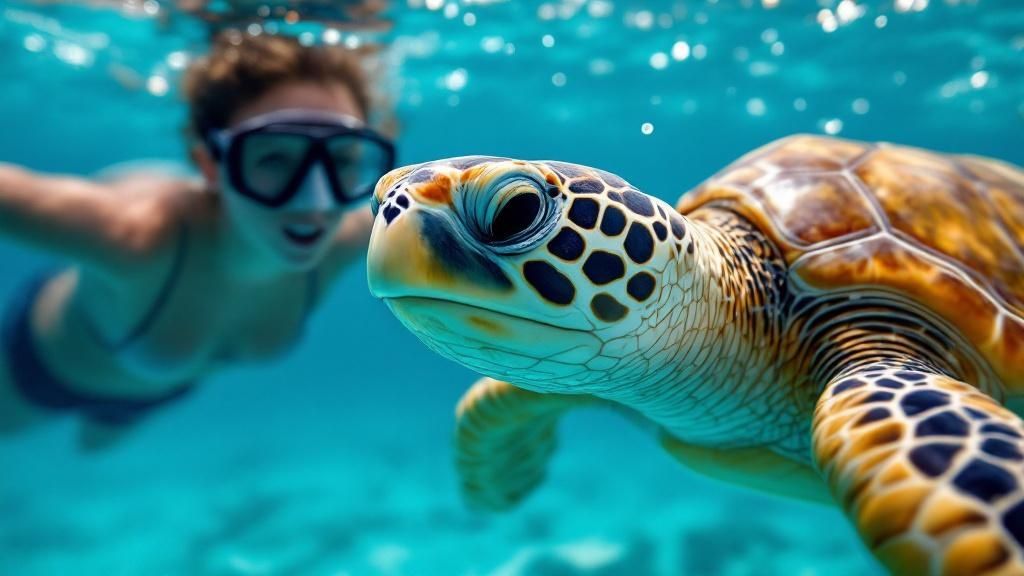
The boat ride over to the bay is an experience in itself, but the real magic of a Captain Cook snorkel tour starts the second you dip your mask in the water. Slipping beneath the surface of Kealakekua Bay feels like stepping into another dimension entirely. It's a living, breathing aquarium, absolutely bursting with color and activity.
Best of all, the fish here aren't skittish. That's because the entire bay is a protected Marine Life Conservation District, which basically means it's a sanctuary for the reef and everything that calls it home. Fishing is heavily restricted, allowing the ecosystem to thrive without human pressure. The result? A stunningly healthy coral garden and fish that are more curious than cautious, giving you an up-close snorkeling experience that’s hard to find anywhere else.
The Stars of the Underwater Show
As you float along, you'll be greeted by an incredible cast of aquatic characters. The sheer volume of fish is something you have to see to believe. Swirling schools of brilliant yellow tangs, often numbering in the hundreds, drift over the reef like golden clouds. You'll also see parrotfish (uhu) noisily crunching on coral and maybe even spot the famous humuhumunukunukuāpuaʻa—Hawaii’s quirky state fish—as it darts between coral heads.
But it’s not just about the fish. Kealakekua Bay is a magnet for other incredible marine life.
- Honu (Green Sea Turtles): It's almost a given that you'll spot these gentle giants gliding gracefully through the water. Watching a honu is a truly humbling, unforgettable experience.
- Spinner Dolphins (Nai'a): While you can't time it perfectly, pods of spinner dolphins often use the calm bay to rest and play. Seeing them leap and spin from the boat is a spectacular bonus to an already amazing day.
- Vibrant Corals: The reef itself is a living city, built from cauliflower coral, lobe coral, and finger coral. This intricate structure provides the perfect home for all the colorful fish and critters.
The exceptional health of Kealakekua Bay's ecosystem means you're not just seeing a few fish; you're witnessing a complete, thriving marine community in its natural state. The biodiversity here is a direct result of decades of conservation efforts.
An Accessible Adventure for Everyone
Because the bay is so well-protected from the open ocean, the water here is usually incredibly calm. This makes it a perfect spot for snorkelers of all skill levels. It doesn't matter if you're a seasoned freediver or trying it for the very first time; the conditions are almost always ideal for a relaxing and safe adventure. The water clarity is often fantastic, too, letting you see all the amazing detail on the reef right from the surface.
This accessibility is a huge part of what makes the Captain Cook snorkel tour so popular. You get all the rewards of a remote, pristine location without needing to be an expert to enjoy it. If you want to dive deeper into what your day will look like, our guide on Big Island Captain Cook snorkeling has even more detail. The blend of easy conditions and world-class marine life means everyone, from kids to grandparents, can have an incredible time in the water.
How To Choose Your Perfect Snorkel Tour
With a few different companies offering a Captain Cook snorkel tour, picking the right one can feel like a major decision. It’s actually simpler than you might think. The real secret is matching the boat and its general vibe to the kind of vacation you’re looking for.
Think of it like choosing a rental car for a road trip. A zippy convertible and a big, comfy minivan will both get you down the same highway, but they deliver two completely different experiences. Your main choice here is between two types of boats: large, stable catamarans and smaller, more adventurous power rafts. Neither is "better"—they just offer completely different days out on the water.
This infographic breaks down a couple of key reasons why Kealakekua Bay is such a world-class spot, no matter which boat you end up on.
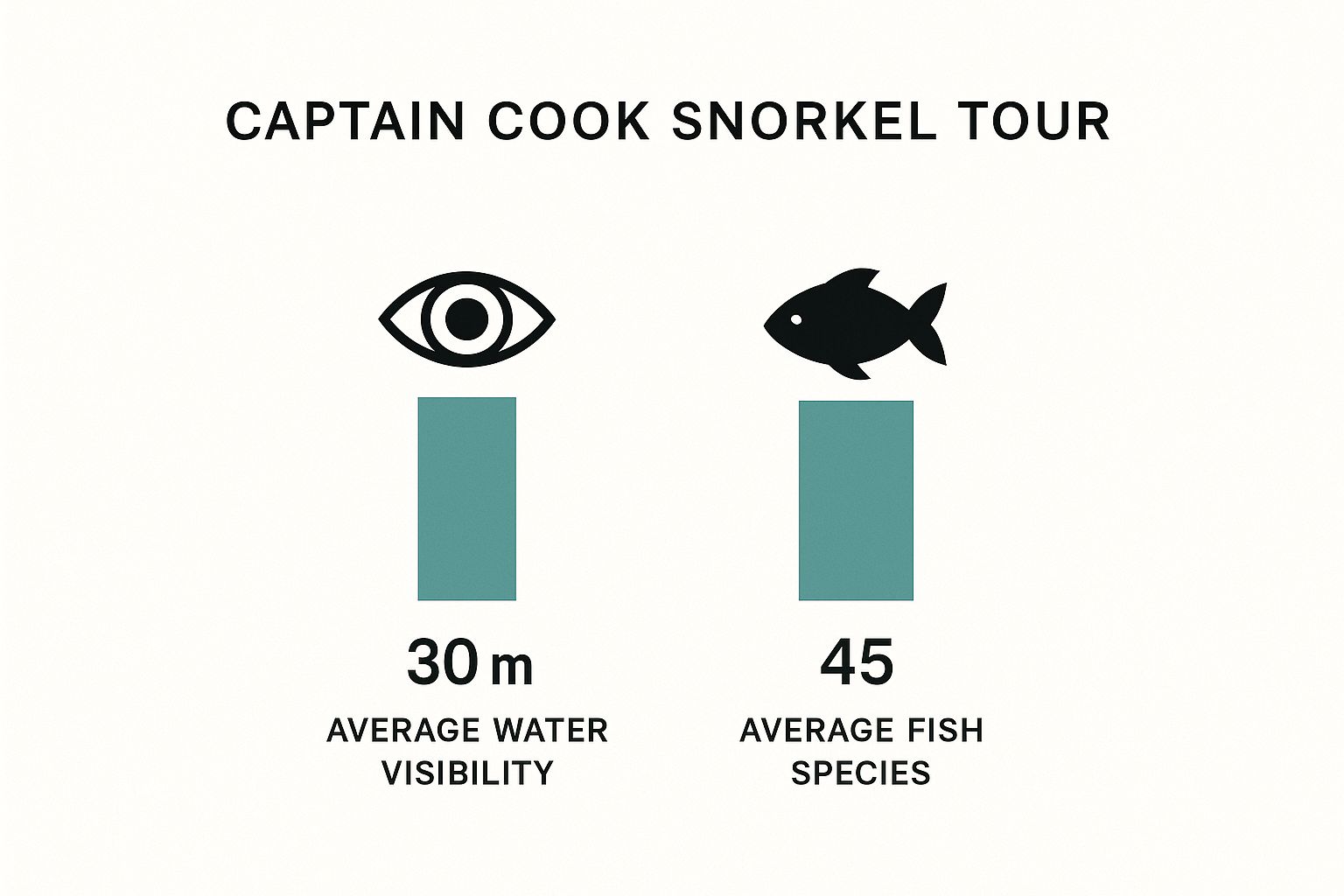
As you can see, the combination of incredible water clarity and a sheer abundance of fish makes this a truly special place for snorkelers.
Comparison of Captain Cook Tour Operators
Choosing the right boat really shapes your day. Are you looking for a relaxing, all-inclusive day on the water, or a nimble, up-close adventure? This table breaks down the key differences between the two main types of tour boats heading to Kealakekua Bay.
| Feature | Large Catamaran | Small Power Raft |
|---|---|---|
| Best For | Families, mixed-age groups, comfort-seekers | Adventurous couples, thrill-seekers, small groups |
| Vessel Type | Spacious, dual-hull boat with lots of deck space | Zodiac-style rigid inflatable boat |
| Group Size | Larger (can feel less personal) | Small & intimate (more guide interaction) |
| Amenities | Onboard restrooms, shade, often includes lunch | Minimal; usually no restrooms or significant shade |
| Ride Experience | Smooth and stable, minimizes seasickness | Fast and bumpy, sits low to the water |
| Bonus Features | Often includes water slides and other water toys | Can explore sea caves and lava tubes inaccessible to larger boats |
Ultimately, both options get you to the same amazing snorkeling spot. Your choice just depends on what kind of "ride" you want along the way.
Large Catamarans: The Comfort-Focused Choice
Large catamarans are basically the floating living rooms of the sea. They’re incredibly stable, ridiculously spacious, and usually loaded with creature comforts. This is your go-to option if you're traveling with young kids, older relatives, or anyone who puts a premium on convenience.
- Plenty of Shade: You’ll find lots of room to get a break from the intense Hawaiian sun.
- Onboard Restrooms: This is a non-negotiable for longer trips, especially with a family in tow.
- Smooth Ride: Their double-hull design slices through the water, making them a great choice for anyone prone to seasickness.
- Food and Drinks: Most will serve a full lunch and have plenty of drinks available, all included in the tour price.
The trade-off? The group size is bigger. Because these boats can hold more people, the experience isn't as intimate. But for many people, having shade and a bathroom is a trade they are more than happy to make.
Small Power Rafts: The Adventurous Option
If you're craving a more thrilling, down-in-the-action kind of day, a small power raft (often a zodiac-style boat) is absolutely the way to go. These boats are fast, agile, and sit low to the water, which makes you feel much more connected to the ocean environment.
Think of it as an off-road adventure, but on the water. The exciting ride is a huge part of the fun, and you'll often get to duck into sea caves and explore lava tubes that bigger boats simply can't reach.
These tours run with much smaller groups, which leads to a more personalized experience with your captain and crew. The downside is the lack of amenities—you won't find a restroom, and shade is minimal at best. It's a more rugged adventure built for those with a bit of a wild streak.
A huge part of any trip to Kealakekua Bay is understanding its history, not just snorkeling its waters. Many tours do a fantastic job of weaving in rich historical context, turning the day into an educational journey. In fact, for about 70% of visitors, the cultural storytelling is a key reason they chose the tour in the first place.
Tour operators often work with cultural advisors to share a respectful and accurate account of Captain Cook's arrival in 1779 and its profound impact on the islands. These tours, which usually last between 3 to 5 hours, transform a fun day of snorkeling into a truly meaningful connection with Hawaiian history. For a deeper dive into what makes these tours unique, check out our guide to the Captain Cook Snorkel Cruise.
When you're deciding on your trip, it's helpful to see how it fits in with a variety of boat activities available to ocean lovers here on the Big Island.
Got your gear sorted and picked out the perfect boat? Awesome. But you probably still have a few questions buzzing around. That's totally normal. Knowing exactly what to expect is the best way to make sure you have a relaxing, incredible day out on the water.
Let's dive into some of the most common things people ask about the Captain Cook snorkel tour. By the end, you'll be ready to book with confidence.
What Should I Bring?
The number one question we get is always about packing. My advice? Think smart, not heavy. Your tour crew will have all the snorkel equipment covered, but you'll want to bring a few personal items to stay comfortable.
- Reef-Safe Sunscreen: This is a big one, and it's non-negotiable. Standard sunscreens are loaded with chemicals like oxybenzone and octinoxate that are devastating to our coral reefs—so much so that Hawaii has banned their sale. Do your part for the fragile ecosystem (and your skin!) by sticking to mineral-based, reef-safe options only.
- Towel and Dry Clothes: You'll be glad you have a warm towel to wrap up in after your swim and a dry shirt for the breezy boat ride back to shore.
- Hat and Sunglasses: The Hawaiian sun is no joke, especially when it's bouncing off the water. A wide-brimmed hat and a good pair of polarized sunglasses will be your best friends.
- Waterproof Camera: Trust me, you're going to want proof of what you see. Whether it's a dedicated underwater camera or just a waterproof case for your phone, you'll be kicking yourself if you can't capture the magic.
Do I Need to Be a Great Swimmer?
We hear this concern all the time: "What if I'm not a strong swimmer?" The short answer is, you don't have to be Michael Phelps to have a fantastic time.
While it helps to be comfortable in the water, the tour operators are pros at helping people of all skill levels. They provide top-notch flotation devices, like foam noodles and life vests, which let you float effortlessly. You can just relax on the surface and focus on the incredible world below without a single thought about treading water. Plus, the water inside Kealakekua Bay is usually incredibly calm, making it a safe and gentle place for first-timers.
It’s a huge misconception that you need serious swimming skills to snorkel. With the right gear and a watchful crew, even the most nervous swimmers can have a safe, wonderful time. The key is to be honest about your comfort level—the crew is there to make sure you feel secure.
The tour is also a huge hit with families. As long as kids are comfortable putting their faces in the water, they usually have an absolute blast. The calm conditions and schools of colorful fish are the perfect recipe for sparking a lifelong love of the ocean.
How Do I Book and When Should I Go?
Timing is key, both for locking in your spot and for the tour itself. My best advice is to book your Captain Cook snorkel tour well in advance. These trips are one of the most popular activities on the island and fill up fast, especially during peak travel times like winter breaks and summer holidays. Don't wait until the last minute!
As for the best time of day to go, you can't beat a morning tour. The water is almost always at its calmest and clearest before the afternoon winds start to pick up. An early start gives you the absolute best visibility for spotting all those vibrant fish and delicate corals.
One last thing—don't forget a credit card or a bit of cash. The tour itself is all-inclusive, but it's customary to tip the captain and crew if they gave you a great day. They work incredibly hard to keep you safe and show you the best of the bay, and a gratuity is a really nice way to show your appreciation for their hard work and expertise.
Ready to experience the magic of Kealakekua Bay for yourself? Kona Snorkel Trips offers world-class tours led by lifeguard-certified guides who are passionate about sharing the beauty of Hawaii with you. Book your unforgettable adventure today at https://www.konasnorkeltrips.com.
